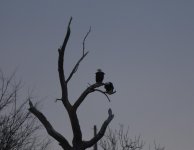Robin W
Senior Member
I am pretty new to photography. I have a Nikon D7200. I got a Tamron 150-600mm G2 for Christmas. I am having trouble getting focused on birds. If they are close there doesn't seem to be to much of a problem but far away they are pretty grainy. The samples below were taken within a 15 minutes of each other, one is clear and one is not. It is about 5 to 5:15 pm. The geese are about 60 yards away and the eagles are on the opposite side of the lake about a quarter of a mile. Also realize guessing distance is not something I am very good at, so approximately.
The geese picture ISO = 4525, F6.3, 1/2500, Eagle picture number 1 ISO = 2263, F6.3, 1/2000, Eagle picture number 2 ISO= 898, F6.3, 1/800. I use Manual mode with ISO set to auto, I have set the auto focus to my backbutton.


The geese picture ISO = 4525, F6.3, 1/2500, Eagle picture number 1 ISO = 2263, F6.3, 1/2000, Eagle picture number 2 ISO= 898, F6.3, 1/800. I use Manual mode with ISO set to auto, I have set the auto focus to my backbutton.



